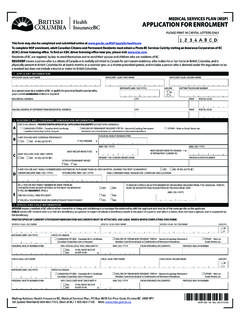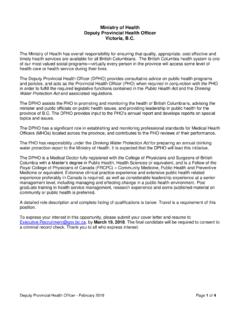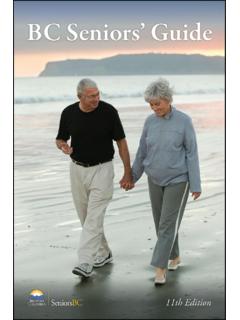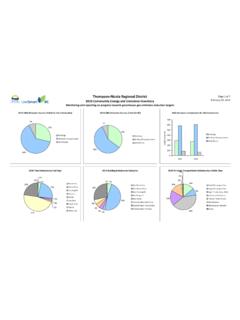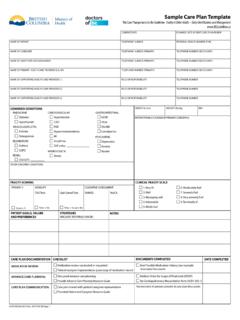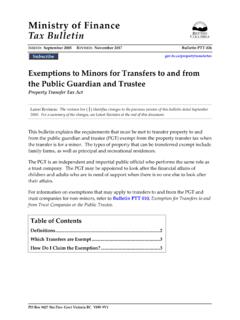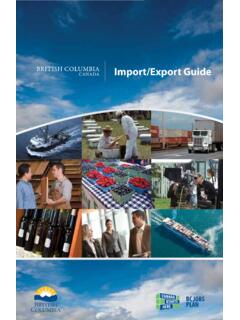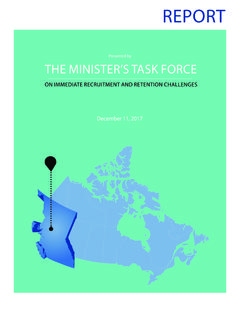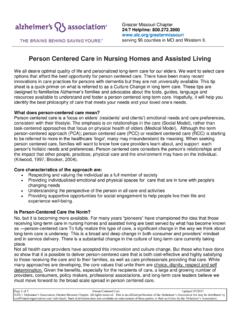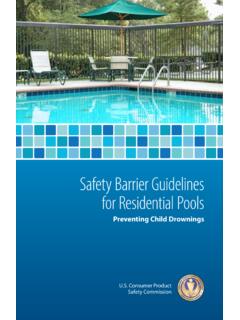Transcription of FOOD AND LIQUOR SERVING PREMISES - DECEMBER 22, 2021
1 ORDER OF THE PROVINCIAL HEALTH OFFICER. (Pursuant to Sections 30, 31, 32, 39 (3), 43, 54, 56, 67 (2) and 69 Public Health Act, 2008). FOOD AND LIQUOR SERVING PREMISES - DECEMBER 22, 2021. The Public Health Act is at: (excerpts enclosed). TO: OWNERS AND OPERATORS OF FOOD SERVICE ESTABLISHMENTS WITH. TABLE SERVICE, FOOD PRIMARY OR LIQUOR PRIMARY ESTABLISHMENTS, INCLUDING PUBS, BARS, LOUNGES AND NIGHTCLUBS, LIQUOR . MANUFACTURING FACILITIES THAT HAVE TASTING ROOMS WITH SEATING, PRIVATE CLUBS OR CERTAIN LICENSED COUNTER SERVICE, TAKE-OUT OR. QUICK SERVICE FOOD SERVICE ESTABLISHMENTS. TO: PATRONS OF FOOD SERVICE ESTABLISHMENTS WITH TABLE SERVICE, FOOD. PRIMARY OR LIQUOR PRIMARY ESTABLISHMENTS, INCLUDING PUBS, BARS, LOUNGES AND NIGHTCLUBS, LIQUOR MANUFACTURING FACILITIES THAT. HAVE TASTING ROOMS WITH SEATING, PRIVATE CLUBS OR CERTAIN. LICENSED COUNTER SERVICE, TAKE-OUT OR QUICK SERVICE FOOD SERVICE.
2 ESTABLISHMENTS. TO: MEDICAL HEALTH OFFICERS. WHEREAS: A. On March 17, 2020 I provided notice under section 52 (2) of the Public Health Act that the transmission of the infectious agent SARS-CoV-2, which has caused cases, clusters and outbreaks of a serious communicable disease known as COVID-19 among the population of the Province of British Columbia, constitutes a regional event, as defined in section 51 of the Public Health Act;. B. A person infected with SARS-CoV-2 can infect other people with whom the infected person is in contact;. C. Vaccination is safe, highly effective, and the single most important preventive measure a person can Ministry of Health Office of the 4th Floor, 1515 Blanshard Street Provincial Health Officer PO Box 9648 STN PROV GOVT. Victoria BC V8W 9P4. Fax: (250) 952-1570. 2. take to protect themselves, their families, and other persons with whom they come into contact from infection, severe illness and possible death from COVID-19.
3 In particular: (a) the vaccines available in British Columbia, in company with other protective and preventive measures, are highly effective and provide protection across all eligible age groups against infection and strong protection against severe illness and death;. (b) most British Columbians have strong and durable protection from SARS-CoV-2 resulting from the extended interval between dose one and dose two of vaccine that is being utilized in British Columbia; in addition, a new vaccine is now being offered which only requires one dose to be effective, and booster doses are being implemented in order to reinforce the protection afforded by vaccination;. (c) a full course of vaccine provides more effective and durable protection against infection and severe illness than natural immunity from prior COVID-19 infection alone, or natural immunity in combination with a single-dose of vaccine; and (d) a full course of vaccine provides highly effective and durable protection from severe illness resulting in hospitalization or death from COVID-19, with illness being mostly milder in vaccinated people who become infected than in unvaccinated people.
4 D. Vaccines, which prevent or reduce the risk of infection with SARS-CoV-2, have been and continue to be readily available in British Columbia and while substantial progress has been made in vaccinating the population of British Columbia 12 years of age and older, and children aged 5 to 11. years of age are now being vaccinated, a portion of the public remains unvaccinated and there are communities where vaccination rates are low;. E. communities with low vaccination rates have experienced rapid spread of SARS-CoV-2, causing serious illness and increases in hospitalizations and intensive care admissions, primarily in unvaccinated people. By contrast, communities with high vaccination rates have seen corresponding lower transmission and case rates;. F. Unvaccinated people are at a significantly greater risk than vaccinated people of being infected with SARS-CoV-2, and those who are infected, experience significantly higher rates of hospitalization, ICU-level care and invasive mechanical ventilation, complications and death when compared with vaccinated people.
5 Unvaccinated people are also at higher risk of transmitting SARS-CoV-2 to other people, including vaccinated people;. G. People who are vaccinated can be infected with SARS-CoV-2, but experience less severity of illness than unvaccinated people, especially in younger populations. Vaccinated persons who contract COVID-19 can transmit SARS-CoV-2 but are also generally contagious for shorter periods of time, are less symptomatic, and are less likely to transmit SARS-CoV-2, when compared to unvaccinated infected persons;. H. This situation has been exacerbated over time, first by the arrival of the highly transmissible Delta variant of SARS-CoV-2, which is now circulating in British Columbia and causing significantly more rapid transmission and increased severity of illness, particularly in younger unvaccinated people, than earlier variants, and now by the arrival of the even more transmissible Omicron variant, which is responsible for a surge in infections in the province, and which I expect will very shortly overtake the Delta variant as the dominant strain of SARS-CoV-2 circulating in the province.
6 3. I. Absent vaccination, British Columbia would be in a far more challenging situation than the fragile balance our current immunization rates have provided, but the transmissibility of the Delta and now the Omicron variant means that higher vaccination rates than previously expected are now required to maintain this balance, control transmission, reduce case numbers and serious outcomes, and reduce the burden on the healthcare system, particularly hospital and intensive care admissions;. J. The Omicron variant has introduced significant uncertainty into the course of the pandemic, and the rapidly rising infection rates in British Columbia and experience in other places have led me to conclude that unless measures are put in place immediately to check the spread of Omicron there will be sufficient serious illness among the public to overwhelm the Province's public health and health care systems, which is already operating beyond capacity.
7 K. Preserving the ability of the public health and health care systems to protect and care for the health needs of the population, including providing care for health needs other than COVID-19, is critical. High incidence of transmission and illness in one or more regions have spill-over effects on health care delivery across the Province, including in critical care and surgical services. Our public health and health care systems are currently experiencing severe stress, and are stretched beyond capacity in their efforts to prevent and respond to illness resulting from the transmission of COVID-19 in the population, primarily among unvaccinated people;. L. Both the public health and the health care systems are using disproportionate amounts of their resources in their efforts to prevent and respond to the transmission of SARS-CoV2, and to provide care for those who become ill with COVID-19, primarily unvaccinated people who comprise the majority of hospitalizations and ICU admissions.
8 M. While people who have contracted SARS-CoV-2 may develop some natural immunity for a period of time following infection, the strength and duration of that immunity varies depending on a multitude of factors, including severity of infection. The risk of reinfection and hospitalization is significantly higher in people who remained unvaccinated after contracting SARS-CoV-2 than in those who were vaccinated post-infection. Vaccination, even after infection, remains an important measure to protect against reinfection. It does so by providing a stronger immune response that is known to be effective for a longer period of time and against a wider variety of strains of SARS- CoV-2 that are currently circulation in British Columbia, including the Delta variant;. N. Vaccination is the single most important preventive measure a member of a community can take to protect themselves and other members of the community, from infection, severe illness and possible death from COVID-19.
9 O. People over 70 years of age, and people with chronic health conditions or compromised immune systems, are particularly vulnerable to severe illness and death from COVID-19, even if they are vaccinated;. P. Included among the members of the community who are more likely to be infected are children aged 5 to 11 years. This is because children in this age group have only recently become eligible for vaccination and it will take some time before the members of this group can be fully vaccinated. Children under the age of 5 will remain unprotected from infection until a vaccine is available for them;. Q. Adults and children who are either particularly vulnerable to infection with SARS-CoV-2 or too young to be immunized depend upon the people with whom they come into contact to protect them 4. from the risk of infection;. R. Unvaccinated people in close contact with other people can promote the transmission of SARS-CoV- 2 and increase the number of people who develop COVID-19 and become seriously ill; in particular, social mingling, particularly when coupled with the consumption of alcohol which increases risky behavior, is associated with increases in the transmission of SARS-CoV-2.
10 S. Programs that require that proof of vaccination be provided have been shown to increase vaccination uptake in populations, thereby reducing the public health risk of COVID-19;. T. There are difficulties and risks in accommodating persons who are unvaccinated, since no other measures are nearly as effective as vaccination in reducing the risk of contracting or transmitting SARS-Co-2, and the likelihood of severe illness and death;. U. I have considered and continue to consider, based on the currently available generally accepted scientific evidence whether other measures, such as natural immunity, PCR testing or rapid antigen testing, are as effective as vaccination in reducing the risk of transmission of SARS-Co-2 or the severity of illness if infected;. V. Routine COVID-19 testing of asymptomatic people is not recommended in British Columbia and polymerase chain reaction (PCR) testing capacity is reserved for people who may be ill with COVID-19 to promote public health case identification, follow up and control measures.
